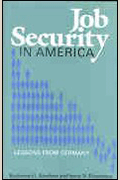Studies in this week’s Hutchins Roundup find that increased employer concentration depresses wages, there is a shortage of safe debt now compared to before the crisis, and more.
Want to receive the Hutchins Roundup as an email? Sign up here to get it in your inbox every Thursday.
Increased employer concentration depresses wages
Analyzing manufacturing plant-level Census Bureau data from 1977 to 2009, Efraim Benmelech of Northwestern, Nittai Bergman of Tel Aviv University, and Hyunseob Kim of Cornell argue that wages are significantly lower in local labor markets where employers are more concentrated. This relationship has strengthened over time and is stronger at high levels of concentration, they show, and is evident even when comparing establishments that belong to the same firm in different geographic areas. The authors also demonstrate that the link between productivity growth and wage growth weakens when employer concentration increases, and document that competition from Chinese exporters leads to higher concentration of domestic employers, resulting in even lower worker wages. Together, the results suggest that increased employer market power may partially explain wage stagnation in the U.S. over the past several decades, they conclude.
There is a shortage of safe debt now compared to before the crisis
When holders of short-term debt doubt the value of the collateral that borrowers pledge, the result can be a run on the banking system and the expansion of a shadow banking system. Examining convenience yields—the spreads between the highest rated private debt and similar-maturity Treasury debt— as a measure of the scarcity of safe assets, Yale’s Gary Gorton and Toomas Laarits assess whether regulatory changes after the 2008 crisis have improved the quality of collateral and the resiliency of the financial system. They show that, although convenience yields have decreased since the crisis, they have not returned to pre-crisis levels. Further, they find that the quantity and maturity of private issuance of short-term debt is more sensitive to changes in Treasury supply than in the pre-crisis period. In all, the results suggest that there is a shortage of safe debt now compared to the pre-crisis period.
Lowering interest rates changes savings behaviors and delays social security claims
Vanya Horneff and Raimond Maurer of the Goethe University Frankfurt and Olivia Mitchell of the University of Pennsylvania simulate saving, investing, and retirement behaviors under various low interest rate scenarios. They use a life cycle model that incorporates tax rules and Social Security benefit formulas and matches observed saving, work, and claiming behavior of U.S. households. They show that as interest rates decrease, people save less and draw upon on their 401(k) assets sooner, and devote more savings to non-retirement accounts. Lowering interest rates also induces people to delay claiming Social Security retirement benefits. When expected returns are lower, the authors explain, claiming Social Security later is attractive because it increases workers’ Social Security benefits, while the cost of pulling from their retirement assets is lower.
Chart of the week: Foreign-born workers are becoming a larger part of the labor force

Quote of the week:
“What’s going on in financial markets? The past week or so has been a roller coaster ride of ups and downs in the stock market, with a sudden increase in volatility. Longer-term bond rates have also moved up. It’s helpful to put this into perspective…Even with the recent movements, as of Friday, the S&P 500 index is still significantly higher than it was a year ago. Bond yields are at levels seen at the start of 2014,” says Cleveland Fed President Loretta Mester.
“While a deeper and more persistent drop in equity markets could dash confidence and lead to a pullback in risk-taking and spending, the movements we have seen are far away from this scenario. I’ll continue to monitor financial market developments closely, but for now, I expect the economy will work through this episode of market turbulence and I have not changed my outlook. In my view, the underlying fundamentals supporting the economy are very sound.”









Commentary
Hutchins Roundup: Employer concentration and wage stagnation, collateral damage, and more
February 15, 2018